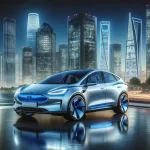In a rapidly evolving electric vehicle (EV) market, industry leaders and analysts often differ on the strategic direction that pioneering companies such as Tesla should take. Recently, a notable voice within the financial sector provided a unique perspective on Tesla’s future endeavors. The crux of the argument suggests a shift in focus toward the development of a more economically accessible EV — the Tesla Model 2 — over the cutting-edge, yet still nascent, Robotaxi concept.
The narrative around Tesla’s product roadmap has been a dynamic one, with various reported plans over time. While the company, led by Elon Musk, has made headlines with ambitious projects, there has been a consistent call from parts of the industry for Tesla to concentrate on a mass-market vehicle. With competitors also vying for dominance in the EV sector, the pressure to deliver on both innovation and affordability has been mounting. Notably, this approach aligns with the broader industry trend toward making EVs more accessible to the average consumer, which is seen as vital for the long-term adoption of electric transportation.
The Analyst’s View on Tesla’s Strategy
According to recent statements by Dan Ives, an analyst from Wedbush Securities, Tesla’s strategy should prioritize the development of the Model 2. The analyst argues that the affordability and accessibility of such a vehicle would be more beneficial for Tesla’s growth than the speculative concept of a Robotaxi. The Model 2, envisioned to be a budget-friendly EV, could address the demand plateau experienced by the EV market due to high prices and lingering range concerns among consumers.
Contrasting Opinions on Tesla’s Next Moves
Despite the argument for affordability, Elon Musk has refuted claims of postponing the $25,000 EV and maintains plans for the Robotaxi prototype, which is set to be unveiled without a steering wheel. Musk’s vision for Tesla includes full autonomy and a next-generation vehicle, which is slated to begin production in the second half of 2025 at Giga Texas.
In supplementary reports by Business Insider and Reuters, there is a consensus that while full autonomy in vehicles is a futuristic goal, the immediate demand lies in reasonably priced electric cars. Business Insider covered Ives’ perspective that Tesla should not solely rely on Robotaxis to replace the concept of the Model 2, and Reuters reported on Tesla’s responses to speculations surrounding its EV plans.
Projecting the Future of Autonomous and Affordable EVs
Industry analysts, including those from Wedbush, forecast that the prime time for fully autonomous vehicles will peak around 2030. However, they stress the importance of Tesla focusing on the here and now by delivering an affordable Model 2 in the shorter term. The balance between delivering immediate value through affordable vehicles and investing in the long-term potential of autonomous technology shapes the ongoing debate in the EV industry.
Useful Information for the Reader
- Model 2 prioritization could meet immediate market demand for affordable EVs.
- Robotaxi concept may remain secondary until full autonomy becomes feasible.
- Giga Texas earmarked as the production site for Tesla’s next-generation vehicle.
Tesla finds itself at a crossroads, with varying opinions on whether it should drive forward with its Robotaxi initiative or switch gears towards an affordable Model 2 EV. The call for a strategic pivot comes at a time when the appetite for EVs is growing, yet the market signals a need for more cost-effective solutions. This juncture demands that Tesla addresses core consumer concerns over pricing and practicality while continuing to trailblaze in autonomous vehicle technology. The ultimate decision could shape the company’s trajectory, influence consumer adoption, and define its competitive edge in the electric automotive landscape.










